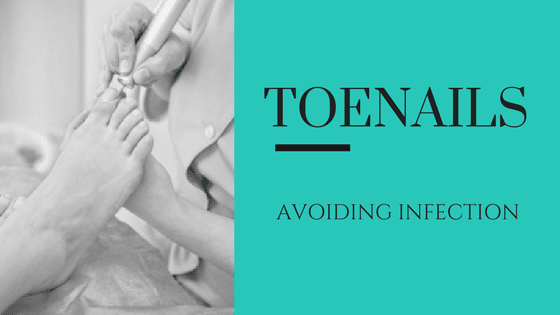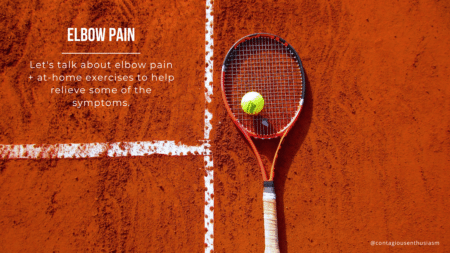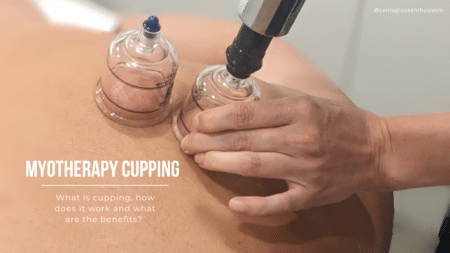Avoiding toenail infections

With a nail salon on just about every corner, having a pedicure or painting your nails is a nice way to spend your Saturday afternoon. However it is not always as glamorous as it sounds for someone who ends up at the podiatrist after his or her visit with a fungal toenail infection.
This is not to entirely discourage people from treating themselves to a pedicure or doing their own nails at home, but to try and educate on the potential risks and some handy tips, so that the next or future pedicures are problem free.
Home Pedicures:
If you are doing your own pedicure at home the first step is choosing the right nail polish for your toenails, and I’m not just talking about what colour best suits your attire.
Since the debut of nail polish it is surprising to some, that the ingredients have only be altered slightly. Nail polish usually consists of coloured pigments, with added film formers suspended in a volatile solvent. The main components to nail polish include the following:
• Nitrocellulose- to create a film that adheres to the nail and allows for oxygen transfer through the polish, creating a non-damaging coating on the nail.
• Toluene sulfonamide formaldehyde- allows the polish to be flexible and prevent cracking, whilst creating a shiny, tough surface. Unfortunately this compound is highly allergenic and many polishes, especially hypoallergenic ones, have removed or replaced this compound with other resins.
• Plasticisers and solvents- to keep the contents in liquid form.
• Colorants and specialty filters- for special effects such as mood changing polish or a marble finish.
Typically, home nail polish application consists of three layers:
• Base coat- a clear layer to protect the nail, minimise staining, prevent chipping and help the pigmented polish to adhere.
• Nail polish- a colour of choice to cover the nail.
• Top Coat- another clear layer, leaving a shiny finish and provides further protection against chipping.
Therefore nail polish itself is a relatively safe product for most people to use, including pregnant women.
Side Effects of Nail Polish:
Two side effects commonly encountered from nail polish and the reason why people present to our podiatry rooms are:
• Staining or discolouration of the nail plate, often mistaken for a fungal infection.
• Allergic contact dermatitis.
Stained or Yellow Nails
Yellow or white staining of the nail is very common from prolonged nail polish use or from colours such as black, deep purple or vivid red. Staining and disclolouration may last up to 14 days or longer following polish removal.
Allergic Contact Dermatitis
Often presents with redness and swelling around the cuticles from a reaction to the toluene resin in the polish.
Handy Hints for Home Pedicures:
Therefore if you are painting your own toenails at home some helpful hints to prevent these problems from happening are as followed:
• Always apply a good quality base coat to the nails to protect from staining.
• Try to avoid the darker colours such as black, purple and red to minimise the risk of staining.
• Never wear nail polish for prolonged periods of time as this may mask underlying problems, such as a fungal infection.
• Do not share nail polish with other people, especially those who have fungal nails.
• Have your own set of separate nail instruments for your feet and hands and do not share your instruments with others.
• Once you have cut your toenails place the clippers in a cup of boiling water with disinfectant for 30 minutes to kill any fungal spores or bacteria.
• If you notice any pigmentations on the toenails that may be fungal, make sure you see a podiatrist to have it diagnosed early and prevent further spreading.
• If you have sensitive skin make sure you buy hypoallergenic polishes and keep cuticles moisturised.
• If any polish causes a reaction to your skin or nail disregard and see a podiatrist or health care professional.
Salon Pedicures:
Now onto salon pedicures that may carry a more severe array of issues, such as infection (bacterial and/or fungal), trauma and allergic reactions.
Possible Side Effects of Salon Pedicures:
Below is a few commonly encounter problems that you need to be aware of when you are visiting nail salons.
Cuticle infections (Paronychia)
While it is common practice at nail salons to push back and/or remove the cuticle this is not always the safest option for your nails. The cuticle of your nail is designed to act as a waterproof barrier to seal the opening of the nail unit and prevent infection getting in. Removal or disruption of the cuticle can cause a paronychia infection defined as inflammation, swelling, pain and occasionally pus around the cuticle.
Permanent Lifting of the Nail (Onycholyis)
From instrument trauma or disruption to the nail matrix, which lies under the cuticle and is responsible for normal cell production. Chronic infection of the cuticle mentioned above may also cause this problem.
Ingrown Toenails
Where the free nail edge pierces into the skin causing a portal for bacteria to get in. This will present as a reddened, swollen, painful, pussy toe. This can be caused but incorrect cutting technique of the nail or digging around the edges of the nail.
Fungal Nails (Onychomycosis)
Due to multi-use instruments (nail clippers, cuticle nippers, drills), there is a high chance of insufficient sterilisation of instruments. Most salons only immerse the instruments in a hot hospital-based disinfectant for 10 minutes between customers or wipe down instruments with a strong disinfectant.
Unfortunately some fungal spores will only die at high temperatures, such as in a autoclave sterilisation machine. These machines are very expensive and usually only found in allied health clinics such as podiatry and dentistry.
If you have a suspected fungal infection you should get this treated before attending a nail salon to prevent the risk of cross infection.
Handy Hints for Salon Pedicures:
How to reduce your risk next time you are at the nail salon and to keep your toenails free from side effects:
• Bring your own instruments to the salon for the beauty therapist to use if you are concerned with the sterilisation standards.
• If you have sensitive skin or want to avoid the risk of staining bring your own nail polish that you know does not stain or cause an allergic reaction.
• Avoid disruption of the cuticle, such as having them pushed too far back or cut.
• Ask to have toenails cut straight across and file the edges smooth to avoid ingrown toenails.
• Seek podiatry or medical advice if any signs of infection both bacterial or fungal present in or around the toenails.
Well Heeled Podiatry uses only sterilised instruments for the cutting and filing of nails and removal of hard skin. All instruments are autoclaved killing all bacterial and fungal spores.
We are trained and skilled in appropriate nail cutting techniques to prevent ingrown toenails and foot pathologies.





